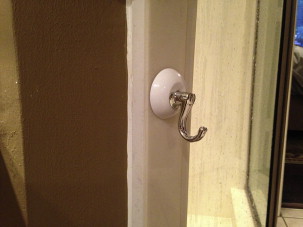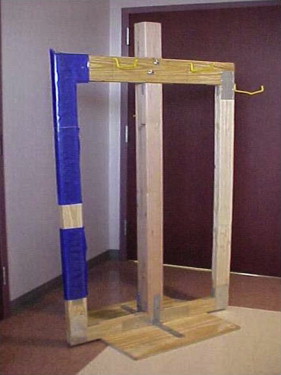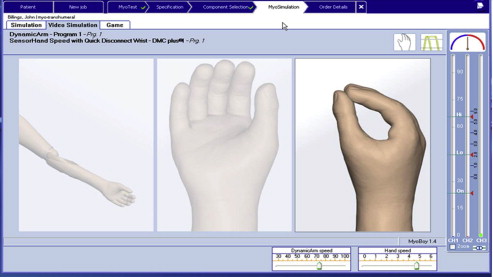Ideally, a collaborative team approach is already in place between the certified prosthetist (CP) and the occupational therapist (OT) before patients are casted for a prosthesis. Once an individual has completed their preprosthetic rehabilitation program and received an operational prosthesis from a CP, it is imperative that an OT provides prosthetic training. Prosthetic training is necessary so that the individual can learn how to use and incorporate the prosthesis into their daily life. Prosthetic training consists of 3 main phases: controls training, repetitive drills, and bimanual functional skill training.
Key points
- •
A collaborative approach is essential to successful rehabilitation.
- •
The choice of componentry determines the training needs.
- •
Prosthetic component manufacturers are a useful resource.
- •
Managing expectations during therapy is crucial in helping minimize client frustration.
- •
Mastering skills before proceeding to the next set of skills during training is vital for improved client outcomes.
Introduction
For the individual who receives an arm prosthesis, occupational therapy is a critical piece of the overall rehabilitation puzzle. An occupational therapist (OT) will help the individual learn to use their prosthesis; use it for activities of daily living (ADL); and, it is hoped, incorporate it into their everyday life. But an OT can only do so much.
If the prosthesis does not fit, is poorly designed, has components that are inappropriate, has components that are assembled incorrectly, and/or is improperly programed, then the OT will struggle greatly or will be unable to train the individual how to use their prosthesis properly. This scenario could lead to frustration for the OT and especially the individual with limb loss. Without proper knowledge of what components are appropriate or how a prosthesis is supposed to fit, individuals might think it is their fault and that they need to try harder and practice more, when ultimately this will lead nowhere. The OT, in turn, may wonder what they are doing wrong. It is imperative that there is constant collaboration and frequent communication between the certified prosthetist (CP) and the OT for the best overall outcome for individuals with an arm prosthesis.
For the purposes of this text, this article solely focuses on adult upper limb prosthetic training. Pediatric prosthetic training will vary significantly secondary to the nature of the limb loss/limb difference. Parental involvement is a crucial factor, and training typically happens in phases according to the various developmental milestones and stages of life. Many resources are available for pediatric prosthetic training.
Introduction
For the individual who receives an arm prosthesis, occupational therapy is a critical piece of the overall rehabilitation puzzle. An occupational therapist (OT) will help the individual learn to use their prosthesis; use it for activities of daily living (ADL); and, it is hoped, incorporate it into their everyday life. But an OT can only do so much.
If the prosthesis does not fit, is poorly designed, has components that are inappropriate, has components that are assembled incorrectly, and/or is improperly programed, then the OT will struggle greatly or will be unable to train the individual how to use their prosthesis properly. This scenario could lead to frustration for the OT and especially the individual with limb loss. Without proper knowledge of what components are appropriate or how a prosthesis is supposed to fit, individuals might think it is their fault and that they need to try harder and practice more, when ultimately this will lead nowhere. The OT, in turn, may wonder what they are doing wrong. It is imperative that there is constant collaboration and frequent communication between the certified prosthetist (CP) and the OT for the best overall outcome for individuals with an arm prosthesis.
For the purposes of this text, this article solely focuses on adult upper limb prosthetic training. Pediatric prosthetic training will vary significantly secondary to the nature of the limb loss/limb difference. Parental involvement is a crucial factor, and training typically happens in phases according to the various developmental milestones and stages of life. Many resources are available for pediatric prosthetic training.
Types of prostheses: an OT’s perspective
The OT essentially needs to know that there are 5 types of prostheses and the various terms that might be used to describe the same type of prosthesis:
- 1.
Cosmetic or passive functional
- 2.
Body powered or cable driven
- 3.
Electrically powered (myoelectric or switch controlled)
- 4.
Hybrid (combination of body powered and electric)
- 5.
Activity specific (designed for a specific task, such as swimming or showering)
But an OT should be able to rely on the CP for more detailed information regarding the various types of prostheses available for individuals with upper limb loss. Please see the article by Kistenberg elsewhere in this issue.
To properly train an individual with an arm prosthesis, the OT must understand the following:
- •
What type of prosthesis their patient has
- •
What componentry is on the prosthesis
- •
If electric, how the components are programed
The OT and CP should communicate on an ongoing and regular basis to discuss any questions regarding the prosthesis as well as any problems, issues, or barriers that might impede training.
Working closely with the CP and prosthetic component manufacturer
The OT should form a close working relationship with the CP and even attend prosthetic appointments with their client if possible and when necessary. The same should go for the CP attending OT appointments because this will only help both professionals understand what it is the other is looking for and more closely appreciate each other’s roles and responsibilities because some items may overlap or one professional might have a resource that the other was unaware of.
The CP has typically formed a relationship with the prosthetic component manufacturer, which is crucial with today’s evolving and rapidly advancing technology. The prosthetic manufacturers offer instructional courses and training on their specific components and technology and, in some instances, require the CP to bring and fit a client in order to become a certified provider of that particular technology. The prosthetic manufacturers encourage the CPs to bring OTs to courses because this helps foster the relationship and enhances the OT’s knowledge base. The OT is not required to understand all of the intricate details of the components, technology, and programing; however, the more knowledge acquired, the better they are able to train individuals how to use their prosthesis and use it in their ADL.
Goals and time frames
The time from an individual being casted for a prosthesis to incorporating it into their daily life varies greatly. General time frames for prosthetic training rehabilitation are available ; but it is important to keep in mind that the rehabilitation time frames are dependent on many factors, which can heavily influence the time spent in therapy. Some of those factors include the following:
- •
Nature of limb loss/limb difference (acquired vs congenital)
- •
Concomitant injuries
- •
Level of limb loss
- •
Number of limbs affected
- •
Type of prosthesis
- •
Componentry used
- •
Programing
- •
Previous prosthetic wear/use
- •
Previous therapy
- •
Experience level of prosthetist
- •
Motivation of client
- •
Client cognition
- •
Experience level of therapist
- •
Availability of client
- •
Availability of prosthetist
- •
Insurance
In some cases, individuals may receive a preparatory prosthesis within a day or two (typically referred to as an expedited fitting); in other cases, it may be months before they receive a definitive or finalized prosthesis. Whether an individual receives a preparatory or definitive prosthesis is up to the prosthetist. It is recommended that the OT be involved from the initial stages of the prosthetic fabrication process and begin training with a preparatory prosthesis. The OT will be able to put the client in various therapy situations, which will help determine if any modifications need to be made before the CP finalizes the prosthesis. It is easier to modify a preparatory prosthesis than a definitive prosthesis. Once training has begun, it could take anywhere from a few days to several months in order for the client to feel proficient with their prosthesis. Again, the time frame depends on the factors mentioned earlier. Managing expectations is important. The proliferation of feel-good stories in the media and online can cause/create a significant disconnect between a client’s expectations and realistic expectations. Early prosthetic training is feasible if there are no outstanding preprosthetic rehabilitation areas to be addressed.
The goals of upper limb prosthetic training should be client centered and meaningful. The OT and family members may also have certain goals in mind for the client that will help them be more independent with basic self-care tasks; but if it is not meaningful to the client, then it may not be appropriate to address it in therapy because it could lead to frustration and a battle of wills. That does not mean the client will not find those tasks meaningful or important in the future, therapy tends to be a process that occurs in phases, and those tasks can always be addressed at a later time. All that being said, it is important to discuss with the client the need for independence with self-care activities in the event someone is not around to help. Some common goals the OT should keep in mind include the following:
- •
Independence with don/doff of the prosthesis
- •
Perform basic self-care tasks independently with the prosthesis or adaptive equipment (feeding, bathing, toileting, dressing)
- •
Perform ADL independently with the prosthesis or adaptive equipment (feeding, meal preparation, grooming, home management)
- •
Engage in leisure activities/hobbies with the prosthesis or adaptive equipment
Occupational therapy initial assessment
It would be ideal if the same OT performed both the preprosthetic evaluation and prosthetic training evaluation, but this may not always be the case. The preprosthetic phase of rehabilitation should have prepared the client and his or her body/limb to wear, tolerate, and use a prosthesis, which will ultimately make the prosthetic training phase much smoother and faster.
If an individual has not received any preprosthetic rehabilitation, it may make the prosthetic training phase difficult for the following reasons:
- •
Range of Motion (ROM) deficits
- •
Strength deficits
- •
Scar tissue adhesions
- •
Edema
- •
Hypersensitivity
- •
Pain issues
For example, adherent scar tissue will affect the individual’s ability to wear a socket without skin breakdown. Edema or volume fluctuation in the residual limb will affect the fit of the socket and ultimately the client’s comfort and/or control ROM or strength deficits will affect the individual’s ability to control the various components on their prosthesis. These areas must be addressed before prosthetic training can begin, and changes to the prosthesis may be necessary once these areas have been resolved. This will be a source of frustration for both the OT and especially the client who was expecting to learn how to use their new prosthesis and instead may feel like they took 3 steps back. Please see the article by Klarich and Brueckner elsewhere in this issue.
In any event, the OT initial assessment should paint a very thorough picture of the individual and describe in detail any problem areas in order to justify what needs to be addressed during the prosthetic training phase and identify barriers to training. The areas to be addressed during the assessment should include, but are not limited to the following:
- •
Cause and onset
- •
Age, hand dominance
- •
Other medical issues
- •
Surgeries
- •
Medications
- •
Level of independence with ADL
- •
ROM
- •
Strength
- •
Skin integrity
- •
Shape of residual limb
- •
Phantom pain
- •
General pain
- •
School and/or work/vocational goals
- •
Support
- •
Home environment
- •
Previous therapies
- •
Previous prostheses
- •
Client goals
Prosthetic delivery overview: an OT’s perspective
The OT is typically the health care professional that spends the most time with individuals with upper limb loss. Although the CP will give an overview of the componentry, explain the various features, provide education regarding prosthetic wear and care, and demonstrate how to put the prosthesis on and take it off, this might only happen when the client first receives their prosthesis. The OT should be familiar with all of the items discussed during prosthetic delivery so it can be reviewed as necessary during prosthetic training. The OT should review the following areas:
- •
Prosthesis wear schedule
- •
Skin checks
- •
How to take care of and clean their prosthetic socket
- •
Harness and components
- •
What hazards to avoid
- •
What the various components are
- •
How the components work/operate on their prosthesis
- ○
Terminal device (TD)
- ○
Wrist
- ○
Harness
- ○
Cables
- ○
Liner
- ○
Socket
- ○
If the prosthesis is electric, the OT should thoroughly review the various components (TD, wrist, and elbow) and how they are programmed. Once the prosthetic training begins, repetition of this information will help it sink in and make more sense.
The OT should also teach clients how to put their prosthesis, including socks and liners, on and remove it independently. There are various methods for don/doff of arm prostheses. The methods will differ depending on the type of socket, type of prosthesis, personal preference, and the level of limb loss. For someone with a body-powered prosthesis, the methods are similar to putting on or taking off a sweater or a coat. If the individual is wearing a myoelectric prosthesis, they may have a suction socket and require a pull sock to don their arm for an appropriate fit and electrode contact. If an individual is missing more than one limb, adaptive equipment may be necessary. The adaptive equipment can range from a simple work hook mounted to a wall or to a complex dressing tree for individuals with higher-level bilateral limb loss ( Figs. 1 and 2 ).


What to look for before training begins
If an individual has an electrically powered prosthesis, it is important for the OT to take a few steps back and assess things at a very basic level. This assessment will help the OT determine if there are any problem areas that could impede training and lead to frustration during the actual training. Problem areas can include but are not limited to the following:
- •
Muscle strength and endurance
- •
Socket fit
- •
Electrode placement
- •
Electrode gain settings
- •
Incorrect wiring
- •
Device programing
- •
Patients’ general understanding/comprehension
Because of the advances in prosthetic technology hardware and software over the past 10 to 15 years, it is now possible to virtually assess an individual’s ability to operate a prosthesis ( Fig. 3 ).









